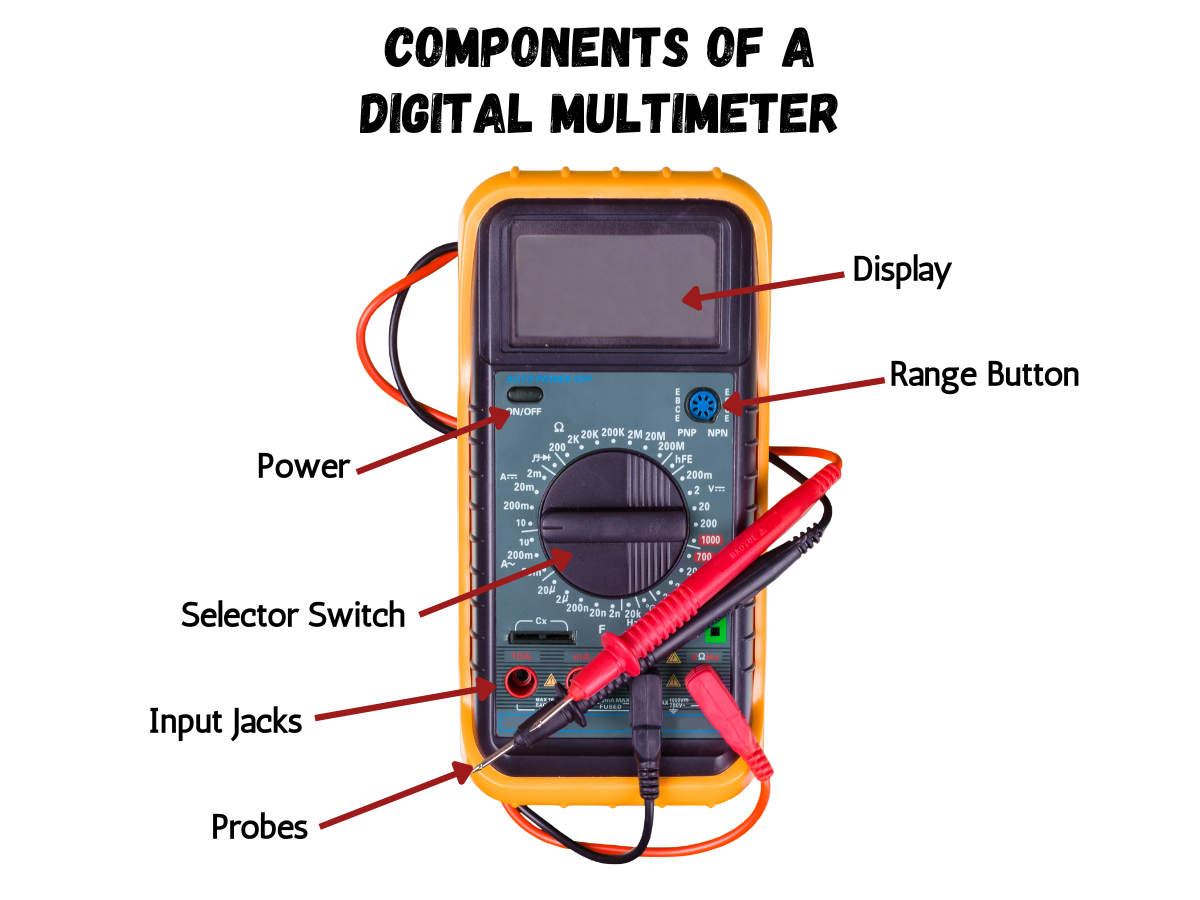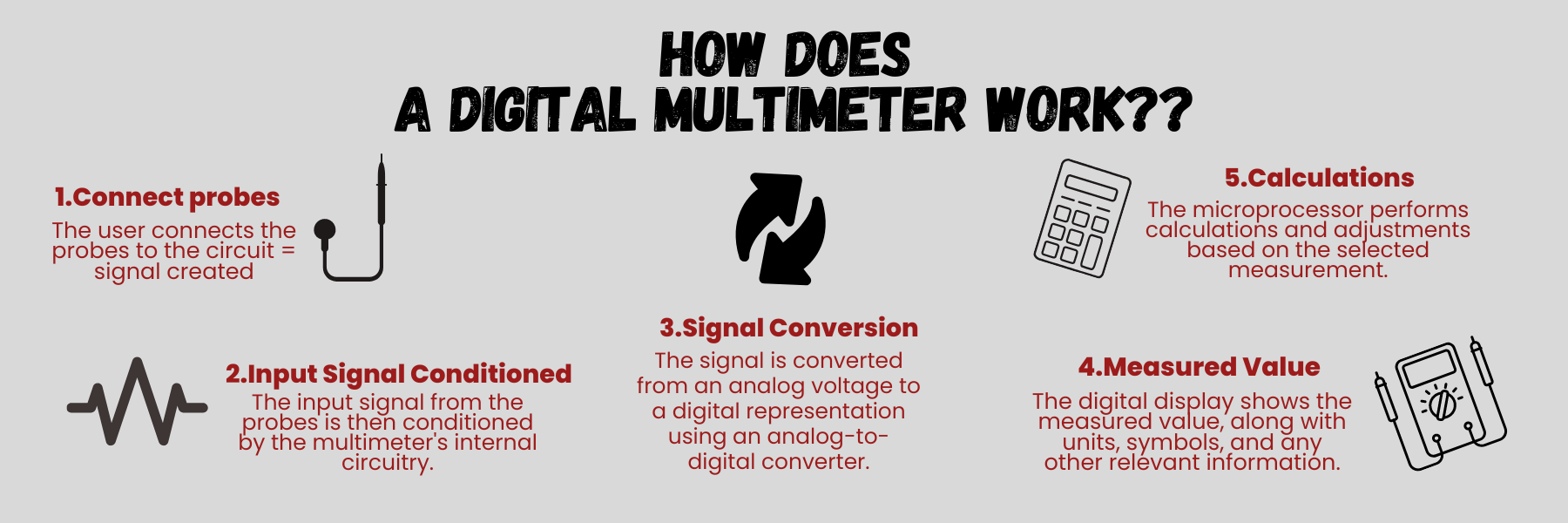Digital Multimeters (DMMs)
The Definitive Guide To Using Multimeters
Digital Multimeters (DMMs)
A digital multimeter (or DMM for short) is a high-tech tool used to measure electricity. It contains a digital readout for measuring things like voltage, current, resistance, capacitance, frequency, and more.
Unlike an analog multimeters that uses mechanical movements and analog scales, DMMs use digital displays, typically consisting of a liquid crystal display (LCD) or LED screen, to provide precise numerical measurements.
DMMs can also offer additional features such as data logging, peak hold, continuity testing with audible beeps, diode testing, temperature measurement with external probes, and more. Some advanced DMMs may even have built-in wireless connectivity or USB ports for data transfer and integration with computer software.
the Definitive Guide to Using Multimeters
This is the fifth article in our series, The Definitive Guide to Using Multimeters.
This article discusses the digital multimeter (DMM) and its relative strengths and weaknesses.
In This Article
If you missed the start of the series: What Is a Multimeter: The Definitive Guide to Multimeters, check it out now! You will be able to work your way back to this article quite quickly.
The Definitive Guide to Multimeters
- What is a Multimeter?
- Why Are Multimeters Important?
- What Do Multimeters Measure?
- What is the History of the Multimeter?
- What are the Common Types of Multimeters?
- What are Common Multimeter Options?
- What are Some Multimeter Specifications?
- What are Common Uses of Multimeters?
- How Do I Choose the Best Multimeter For The Job?
- How Do I Use a Multimeter?
- How Do I Properly Maintain a Multimeter?
- How Do I Calibrate a Multimeter?
- What is the Future of Multimeters?
- Multimeter FAQs
Digital Multimeter Components
The main components of a typical digital multimeter (DMM) are:
- Display
- Selector Switch/Buttons
- Range Button
- Power Button
- Probes
- Input Jacks
- Battery Compartment
- Microprocessor/ASIC
- Internal Circuitry
Display
The display is one of the essential components of a digital multimeter. It can be an LCD (Liquid Crystal Display) or an LED (Light-Emitting Diode) screen. The display shows the measured values and other relevant information, such as units, symbols, and mode indicators.
Selector Switch/Buttons
Digital multimeters have a selector switch or buttons that allow you to choose the measurement function and range. The switch/buttons are used to select options such as voltage (AC or DC), current (AC or DC), resistance, capacitance, frequency, and temperature.
Range Button
Digital multimeters often have a range button that allows you to manually cycle through different measurement ranges. This button helps you select the appropriate range based on the expected magnitude of the measurement. Some DMMs also feature auto-ranging, where the instrument automatically selects the optimal range.
Power Button
Digital multimeters have a power button to turn the device on and off, helping conserve battery life when the multimeter is not in use.
Probes
Digital multimeters typically come with detachable probes for making electrical connections. The probes consist of a red (positive) and a black (negative) lead with metal tips or clips. These probes are used to connect the multimeter to the circuit or component being measured.
Input Jacks
Digital multimeters have input jacks where the probes are connected. The jacks are color-coded to match the color of the probes, typically red for positive and black for negative. The input jacks are labeled according to the measurement type, such as voltage, current, or resistance.
Battery Compartment
DMMs are powered by batteries, and they have a battery compartment for easy replacement when needed. The compartment is typically located on the back or bottom of the multimeter.
Microprocessor/ASIC
Digital multimeters contain a microprocessor or an Application-Specific Integrated Circuit (ASIC) that handles the measurement processing, conversion, and display functions. The microprocessor interprets the input signals and calculates the appropriate measurement values for display.
Internal Circuitry
Digital multimeters have internal circuitry that includes amplifiers, analog-to-digital converters (ADC), and other components necessary for signal conditioning, measurement accuracy, and data processing.

How Does a Digital Multimeter Work?
1. Probes Connected
When the user of the multimeter connects the probes to the circuit or component being measured, an input signal is created.
2. Input Signal Conditioned
The input signal from the probes is then conditioned by the multimeter's internal circuitry. This circuitry may include amplifiers, filters, and other components to ensure accurate and reliable measurements.
3. Signal Converted
The conditioned signal is converted from an analog voltage or current into a digital representation using an analog-to-digital converter (ADC). The ADC samples the signal at regular intervals and assigns a digital value to each sample based on its amplitude.
4. Calculations Performed
Once the signal is digitized, it undergoes further processing by the multimeter's microprocessor (or ASIC). The microprocessor performs calculations and adjustments based on the selected measurement function, range, and any additional features enabled.
5. Measurement Displayed
Finally, the processed measurement value is sent to the multimeter’s display. The digital display shows the measured value, along with units, symbols, and any other relevant information.

What's Next: The Definitive Guide to Multimeters
Now that we know all about digital multimeters, its time to explore the differences between digital multimeters and their brother, analog multimeters.
In the next section, we will dive explore these differences in detail and set you up to make the best decision of what is right for you. Lets get started and head to Section 5: Analog vs. Digital Multimeters.
ISO/IEC 17025 Accredited Multimeter Calibration
Fox Valley Metrology proudly offers accredited precision measuring instrument calibration services of Multimeters. We calibrate all types of Multimeters at our offices throughout the country, meaning we are sure to have local Multimeter calibration services near you.
- ✓ ISO 17025 accredited calibration vendor
- ✓ Broadest calibration scope in the industry
- ✓ 3-5 day turnaround time for laboratory calibrations
- ✓ Pickup and delivery service options available
- ✓ Onsite calibrating service options